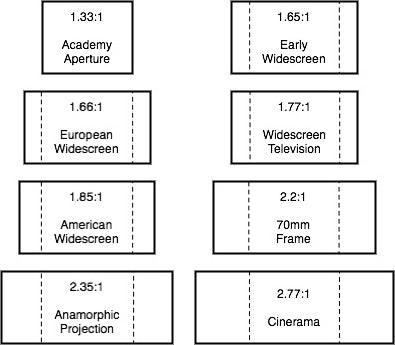
Screen format, Aspect Ratio and Resolution - In which ways are these related?
Share
What is aspect ratio? You often hear that in connection with home cinema, projectors and screens. The terms 4 to 3, 16 to 9 or 2.35 to 1 are often used here, but what does this mean for my screen selection?
See also our video on the subject on the Elite Screens Europe YouTube channel
The term aspect ratio says something about the height and width ratios of the visible area of a screen. For example, a 1:1 aspect ratio means that for every horizontal unit, there is one vertical unit. Compared to 4 : 3, this means that for every 3 units of height, 4 units of width are available. Earlier televisions, beamers and projection screens were mostly in 4:3 format due to the prevailing PAL signal at that time. 4:3 and even 1:1 aspect ratio screens are still being used in business and education today, although they are clearly being supplanted from 16 to 9. The 2.35 : 1 format is becoming more common in home cinema. The 16:9 aspect ratio is the most popular format today for 2 reasons. On the one hand, the HD television is in 16:9 format and on the other hand, most of the cinema content is mastered in HD. This is due to the fact that both 4:3 and 2.35:1 aspect ratios can be displayed on a 16:9 format. There are black bars on the sides or top and bottom at 2.35:1, but you can live with that. The 2.35:1 aspect ratio is also known as Anamorphic or Cinemascope. This is a format originally derived from 35mm film projections. It's still very popular in today's digital cinemas, although its roots lie in the celluloid era. As a result, many home theater fans use 2.35:1 screens in their home theaters to display anamorphic content just like in professional theaters. One of the disadvantages of this format has to do with the fact that displaying this aspect ratio requires additional accessories, such as the close-up lens shown here, also known as an anamorphic lens. In addition to the aspect ratio, the existing resolution must also be considered. In most cases, the number of pixels the projector has will determine its aspect ratio. For example, a Full HD projector has 1920 x 1080 pixels in a 16:9 ratio, which is ideally displayed on a screen with a 16:9 aspect ratio. Projectors have been sold with a variety of different resolutions for as long as there have been projectors. In order to simplify it, we have presented the most common resolutions and their aspect ratios in a table and thus show which screen format you need for optimal image display. A wider aspect ratio does not equate to a higher resolution.
The only way to get higher resolution is to use a 4K or Ultra HD projector, which has a native resolution of 3840 pixels wide by 2160 pixels high. That's more than 8 million pixels. Tensioned screens should then be used here, as they offer excellent flatness and thus support the sharpness of the image.
 Explore Electric Projection Screens
Explore Electric Projection Screens Electric Floor-Up Screens
Electric Floor-Up Screens Explore High Contrast Screens
Explore High Contrast Screens Explore Screen Materials
Explore Screen Materials Frame Projection Screens
Frame Projection Screens Explore All Portable Screens
Explore All Portable Screens Explore All Manual Screens
Explore All Manual Screens English
English German
German French
French Spanish
Spanish Italian
Italian Netherland
Netherland